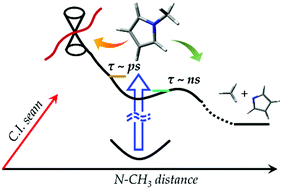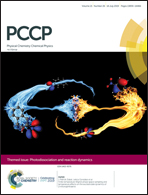Mode-specific excited-state dynamics of N-methylpyrrole†
Abstract
State-selective deactivation rates of N-methylpyrrole in the S1 state have been measured by using the picosecond pump–probe method. The S1 decay time leading to the N–CH3 bond dissociation is found to be strongly mode-dependent as manifested in both S1 decay and methyl-fragment growth dynamics. Time-resolved velocity-map ion images of the ˙CH3 fragment, as far as the fragment of the Gaussian-shaped high kinetic energy distribution is concerned, suggest that the N–CH3 cleavage reaction might occur through an intermediate. Sudden decrease of the S1 lifetime at ∼700 cm−1 above the S1 origin is accompanied by the fragmentation of the Boltzmann-type low kinetic energy distribution. The appearance rate of this low-kinetic energy fragment turns out to be quite slow to give τ ∼ 5 ns compared to the S1 lifetime of ∼174 ps at the +806 cm−1 band, for instance, confirming previous findings that the S1 decay process starts to be overwhelmed by a new fast nonradiative transition in the corresponding excitation energy region. The lifetime at the S1 origin accessed by the two-photon absorption is firstly measured to give τ ∼ 8 ns. Using one and two photon absoption processes, a number of S1 vibronic bands are identified to give mode-dependent lifetimes spanning an enormously wide temporal range of 8 ns–5 ps in the quite narrow excitation energy region of 0–1800 cm−1 above the S1 origin. Understanding of the N-methylpyrrole dynamics on multidimensional excited-state potential energy surfaces governing energy dissipating processes will get much benefit from our detailed mode-specific lifetime measurements.

- This article is part of the themed collection: Photodissociation and reaction dynamics


 Please wait while we load your content...
Please wait while we load your content...